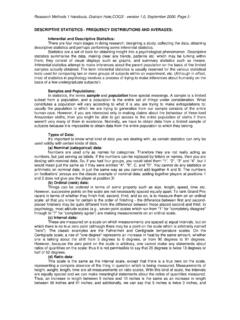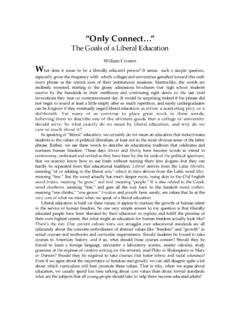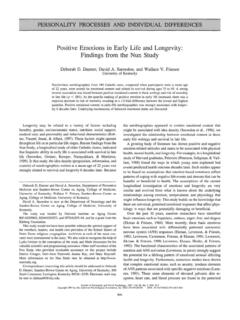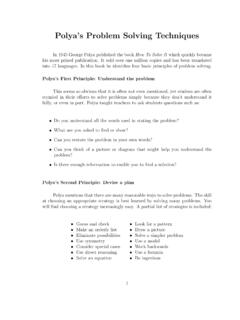Transcription of The Nature of Love - University of Sussex
1 The Nature of Love Harry F. Harlow (1958)[1] University of Wisconsin Address of the President at the sixty-sixth Annual Convention of the American Psychological Association, Washington, D. C., August 31, 1958. First published in American Psychologist, 13, 573-685. Love is a wondrous state, deep, tender, and rewarding. Because of its intimate and personal Nature it is regarded by some as an improper topic for experimental research. But, whatever our personal feelings may be, our assigned mission as psychologists is to analyze all facets of human and animal behavior into their component variables. So far as love or affection is concerned, psychologists have failed in this mission. The little we know about love does not transcend simple observation, and the little we write about it has been written better by poets and novelists.
2 But of greater concern is the fact that psychologists tend to give progressively less attention to a motive which pervades our entire lives. Psychologists, at least psychologists who write textbooks, not only show no interest in the origin and development of love or affection, but they seem to be unaware of its very existence. The apparent repression of love by modem psychologists stands in sharp contrast with the attitude taken by many famous and normal people. The word "love" has the highest reference frequency of any word cited in Bartlett's book of Familiar Quotations. It would appear that this emotion has long had a vast interest and fascination for human beings, regardless of the attitude taken by psychologists; but the quotations cited, even by famous and normal people, have a mundane redundancy.
3 These authors and authorities have stolen love from the child and infant and made it the exclusive property of the adolescent and adult. Thoughtful men, and probably all women, have speculated on the Nature of love. From the developmental point of view, the general plan is quite clear: The initial love responses of the human being are those made by the infant to the mother or some mother surrogate. From this intimate attachment of the child to the mother, multiple learned and generalized affectional responses are formed. Unfortunately, beyond these simple facts we know little about the fundamental variables underlying the formation of affectional responses and little about the mechanisms through which the love of the infant for the mother develops into the multifaceted response patterns characterizing love or affection in the adult.
4 Because of the dearth of experimentation, theories about the fundamental Nature of affection have evolved at the level of observation, intuition, and discerning guesswork, whether these have been proposed by psychologists, sociologists, anthropologists, physicians, or psychoanalysts. The position commonly held by psychologists and sociologists is quite clear: The basic motives are, for the most part, the primary drives -- particularly hunger, thirst, elimination, pain, and sex -- and all other motives, including love or affection, are derived or secondary drives. The mother is associated with the reduction of the primary drives -- particularly hunger, thirst, and pain -- and through learning, affection or love is derived. It is entirely reasonable to believe that the mother through association with food may become a secondary-reinforcing agent, but this is an inadequate mechanism to account for the persistence of the infant-maternal ties.
5 There is a spate of researches on the formation of secondary reinforcers to hunger and thirst reduction. There can be no question that almost any external stimulus can become a secondary reinforcer if properly associated with tissue-need reduction, but the fact remains that this redundant literature demonstrates unequivocally that such derived drives suffer relatively rapid experimental extinction. Contrariwise, human affection does not extinguish when the mother ceases to have intimate association with the drives in question. Instead, the affectional ties to the mother show a lifelong, unrelenting persistence and, even more surprising, widely expanding generality. Oddly enough, one of the few psychologists who took a position counter to modern psychological dogma was John B.
6 Watson, who believed that love was an innate emotion elicited by cutaneous stimulation of the erogenous zones. But experimental psychologists, with their peculiar propensity to discover facts that are not true, brushed this theory aside by demonstrating that the human neonate had no differentiable emotions, and they established a fundamental psychological law that prophets are without honor in their own profession. The psychoanalysts have concerned themselves with the problem of the Nature of the development of love in the neonate and infant, using ill and aging human beings as subjects. They have discovered the overwhelming importance of the breast and related this to the oral erotic tendencies developed at an age preceding their subjects' memories. Their theories range from a belief that the infant has an innate need to achieve and suckle at the breast to beliefs not unlike commonly accepted psychological theories.
7 There are exceptions, as seen in the recent writings of John Bowlby, who attributes importance not only to food and thirst satisfaction, but also to "primary object-clinging," a need for intimate physical contact, which is initially associated with the mother. As far as I know, there exists no direct experimental analysis of the relative importance of the stimulus variables determining the affectional or love responses in the neonatal and infant primate. Unfortunately, the human neonate is a limited experimental subject for such researches because of his inadequate motor capabilities. By the time the human infant's motor responses can be precisely measured, the antecedent determining conditions cannot be defined, having been lost in a jumble and jungle of confounded variables.
8 Many of these difficulties can be resolved by the use of the neonatal and infant macaque monkey as the subject for the analysis of basic affectional variables. It is possible to make precise measurements in this primate beginning at two to ten days of age, depending upon the maturational status of the individual animal at birth. The macaque infant differs from the human infant in that the monkey is more mature at birth and grows more rapidly; but the basic responses relating to affection, including nursing, contact, clinging, and even visual and auditory exploration, exhibit no fundamental differences in the two species. Even the development of perception, fear, frustration, and learning capability follows very similar sequences in rhesus monkeys and human children. Three years' experimentation before we started our studies on affection gave us experience with the neonatal monkey.
9 We had separated more than 60 of these animals from their mothers 6 to 12 hours after birth and suckled them on tiny bottles. The infant mortality was only a small fraction of what would have obtained had we let the monkey mothers raise their infants. Our bottle-fed babies were healthier and heavier than monkey-mother-reared infants. We know that we are better monkey mothers than are real monkey mothers thanks to synthetic diets, vitamins, iron extracts, penicillin, chloromycetin, 5% glucose, and constant, tender, loving care. During the course of these studies we noticed that the laboratory raised babies showed strong attachment to the cloth pads (folded gauze diapers) which were used to cover the hardware-cloth floors of their cages. The infants clung to these pads and engaged in violet temper tantrums when the pads were removed and replaced for sanitary reasons.
10 Such contact-need or responsiveness had been reported previously by Gertrude van Wagenen for the monkey and by Thomas McCulloch and George Haslerud for the chimpanzee and is reminiscent of the devotion often exhibited by human infants to their pillows, blankets, and soft, cuddly stuffed toys. Responsiveness by the one-day-old infant monkey to the cloth pad is shown in Figure 1, and an unusual and strong attachment of a six-month-old infant to the cloth pad is illustrated in Figure 2. The baby, human or monkey, if it is to survive, must clutch at more than a straw. We had also discovered during some allied observational studies that a baby monkey raised on a bare wire-mesh cage floor survives with difficulty, if at all, during the first five days of life. If a wire-mesh cone is introduced, the baby does better; and, if the cone is covered with terry cloth, husky, healthy, happy babies evolve.














